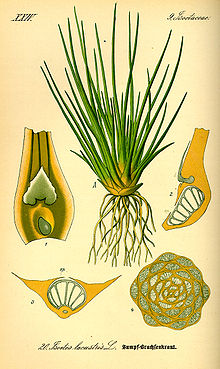Isoetales
| Isoetales | |
|---|---|

| |
| Isoetes | |

| |
| Pleuromeia | |
| Scientific classification | |
| Kingdom: | Plantae |
| Clade: | Tracheophytes |
| Clade: | Lycophytes |
| Class: | Lycopodiopsida |
| Order: | Isoetales Prantl |
| Families | |
|
Chaloneriaceae† | |
Isoetales, sometimes also written Isoëtales, is an order of plants in the class Lycopodiopsida.
There are about 140-150 living species, all of which are classified in the genus
Isoetes are the only living pteridophytes capable of secondary growth.[1]
Fossils
Some authors include the tree-like "aboresecent lycophytes", which formed forests during the Carboniferous period, and often assigned to their own order, Lepidodendrales, within Isoetales.[2]
Fossilised specimens of Isoetes beestonii have been found in rocks dating to the latest Permian-earliest Triassic.[3][4] During the Early Triassic, Isoetales, such as the long-stemmed Pleuromeia were dominant over large areas of the globe.[5] The oldest fossil closely resembling modern quillworts is Isoetites rolandii from the Late Jurassic of North America.[6]
References
External links
 Media related to Isoetales at Wikimedia Commons
Media related to Isoetales at Wikimedia Commons- World list of all species in order Isoetales from World Ferns by M. Hassler in the Catalogue of Life, 203 species.
 Data related to Isoetales at Wikispecies
Data related to Isoetales at Wikispecies
